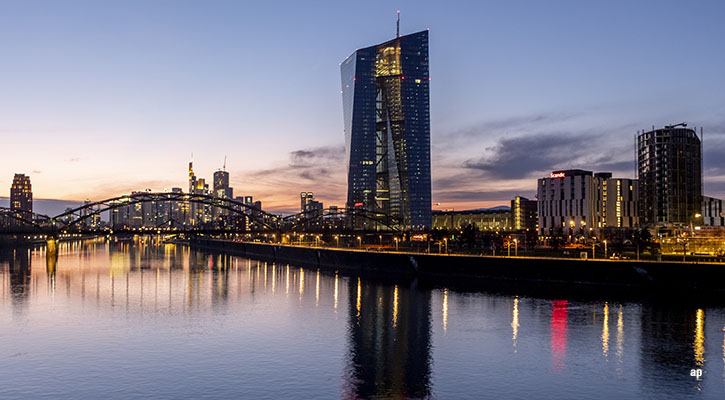
It's been a wild month for markets, and bonds were no exception. Yields on the 10-year US Treasury note dropped from 4.29% to 3.78% in days amid worries about a weakening economy and the prospect of deeper-than-expected interest rate cuts.
The bond market has stabilised, but yields are still roughly 1% lower than their April peak. Charles Schwab chief fixed-income strategist Kathy Jones expects yields to keep falling, but she says opportunities remain outside Treasury bonds. And with more volatility likely ahead, she cautions investors against making knee-jerk decisions.
"We're all subject to all these biases," Jones says, "and it's pretty easy to get caught up in all this stuff, whether you tend to get very fearful or overly aggressive." She says focusing on the coupon element of a bond portfolio – the annual interest payment, which tends to be predictable over the long term – and employing "set it and forget it" strategies like bond ladders can help take human error out of the equation in an uncertain market.
Bonds Are Doing Their Job Again
For Jones, the stock market's recent selloff had an important silver lining: Bonds moved in the opposite direction. "The good news is that bonds are acting like they're supposed to," she explains. When stocks plunged on fears of a growth slowdown and tech stocks lost momentum, bonds rallied sharply. The Morningstar US Market Index is down 2.27% over the past month, while the Morningstar US Core Bond Index has risen 1.75%.
"That's exactly what [bonds] should be doing in a situation like that," Jones says. "They should be a safe haven where investors go when there's a high degree of uncertainty." That's a major change from 2022, when bonds and stocks plunged together.
Bond Yields Headed Lower, but Opportunities Remain
The less-than-great news, Jones says, is that we should expect lower yields in the months ahead as the Federal Reserve eases policy. That means the "perfect moment" to lock in higher yields on the longer end of the curve has likely passed. "The economy is slowing, inflation is coming down. We expect the Fed to start cutting rates in September. And all that means bond yields should go lower," she explains. "The opportunity set we saw a month, two months, six months ago to lock in 5% [yields] is diminished greatly."
That said, Jones believes investors still have room to find higher yields on the order of 4.5% or even 5.0% outside the Treasury market. Yields broadly are still "not too bad," she says, "when you look forward in a declining rate environment. I think it still can make sense for people." She points to investment-grade corporate bonds and mortgage-backed securities. And since bond prices tend to rise as yields fall, investors can expect a little more return on their bond holdings in the interim.
Focus on the Coupon
However, that doesn't mean long-term investors should chase price appreciation. Between lower yields and the potential for more volatility, Jones says it's important to maintain a long-term view rather than worry about price swings. Historically, most return investors see from bonds comes from coupon payments, not price appreciation.
Jones says the iShares Core US Aggregate Bond ETF (AGG), often used as a proxy for the bond market as a whole, is up roughly 3% so far this year. That's true even though yields and prices are essentially flat for the year (with a healthy dose of volatility in between). "You have a positive return because you earn those coupons," she says.
Why Timing the Bond Market Won't Work
Jones encourages investors to think about their fixed income allocations as just that—income—as well as a diversification and capital preservation strategy, rather than get caught up in the day-to-day action of the bond market. "Everyone's always trying to time the market, which we don't suggest," she says. That impulse can lead to a common, costly pitfall. "It’s tough," Jones says, for an investor to watch a bond fund's net asset value (the aggregate price of every share) move up and down. "People get really nervous, and they tend to do the wrong thing," she says. "They sell when it's down."
Selling a bond fund at a low means missing out on returns, Jones explains: "The bond manager will most likely be getting rid of the low coupon bonds and buying the higher coupon bonds, they might be taking some tax losses, and so you've locked in the loss without any of the upside."
The antidote? "Stick to your time frame. Don't buy a bond fund with a five- or 10-year duration and sell it in six months because it's down." Investors who hold bonds for their entire maturity can expect to earn close to the coupon yield, but that's not the case for investors who sell early.
Consider Bond Ladders
While peak yields may be in the rearview mirror, Jones says it's never a bad time to keep an eye on your portfolio and rebalance if necessary. For investors looking to add more fixed income to their portfolios, she points to bond ladders—a portfolio of bonds that mature at regular intervals. "We always like bond ladders because it takes people out of the business of trying to time the market," Jones says. "If you put on a bond ladder and just reinvest, you should be okay over time."
This article originated on our US homepage and has been re-edited for UK audiences. The author or authors do not own shares in any securities mentioned in this article. Find out about Morningstar’s editorial policies




























